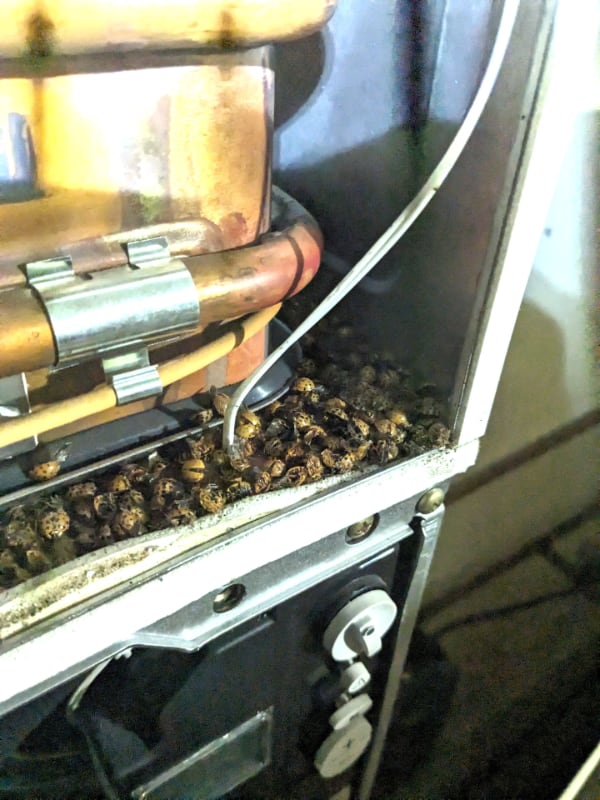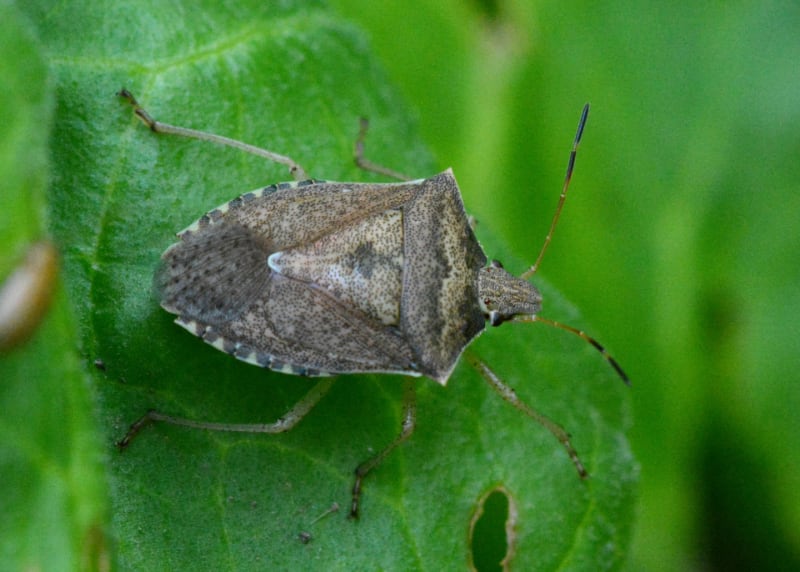
We’re not-so-slowly being overrun by invasive animal and plant species, and it’s costing money. Costing me money in particular.
And like so many terrible things for which no one can be held personally accountable, in many cases the government is to blame.
This month I’ve had to pay close enough to $1500 as makes no difference to undo the effects of a deliberate federal program, an experiment that went horribly wrong. Now that the leaves are gone I will spend a lot of time and shed a lot of blood due to a deliberate federal program from decades ago, another experiment that went horribly wrong.
When I moved here 18 years ago I had, for a few months, something unique to areas where natural gas is found: free gas. It is a phenomenon difficult for most people to understand, and was for me. There was a gas well across the road and down the hill, and because it was on the property of the people from whom I was buying my house, the gas went both into a big tank and via underground hose to my house.
I was buying the land on this side of the road, so I wasn’t technically entitled to free gas, but I had a few months’ leeway. I would have to switch to propane. I shopped carefully — while the furnace could be converted, the water heater could not — and settled on a Bosch tankless water heater. It wouldn’t be on all the time, keeping a big tank of water hot when I wasn’t using it, so it saved a lot of gas. It was the responsible thing to do. I asked around and learned that my neighbor, Mike Gabriel, was the guy to do the installation. He was competent and didn’t charge much. It was his first tankless installation. (He would sadly die a half-mile from here in a motorcycle accident a few weeks later.) It worked perfectly until the first of this month.
Several years ago the old furnace had fallen into disrepair and I had to replace that, too. I got a new, very small one — the size of a two-drawer file cabinet — that made more heat with less gas. I was satisfied until February 2022, when I came down with a miserable, month-long case of COVID-19. I had been counting on that furnace. It was a cold winter. But it just, as they say here, up and stopped. Because of my raging disease I was disinclined to call the furnace guy. So my COVID-19 included frequent trips outside to bring in firewood for the wood stove, and an enormous electric bill from the space heaters when I just couldn’t go fetch wood.
I got better, slowly, and spring came and I forgot about the furnace, which I use only when it is extremely cold. Last winter was mild, so I didn’t fire it up at all.
We had a cold snap here in late October and the furnace, set to 65 degrees, didn’t come on. Oh, yeah. It’s broken. I called the furnace guy, a fine fellow who is also a fireman. He came the next day. He was puzzled — everything seemed fine except that the furnace didn’t work.

This coincided with the Bosch tankless water heater ceasing to perform its one function, which happened while I was in the middle of a shower. I figured I must be out of gas, so first thing I called the gas company and ordered some more. It didn’t help.
What has this to do with invasive species?
A couple of decades ago the U.S. Department of Agriculture in its infinite wisdom decided that soybean crops would grow if aphid populations declined and that just the thing to bring this about was the Asian ladybug. So, many of them got turned loose here. It proved less effective than was hoped, but the new insect liked the United States just fine. Unlike the native species of fond memory and children’s poetry, this evil insect is all over the place. It smells bad. It consumes the larvae of native ladybugs. And, at no extra cost, the damned thing bites! In spring and autumn it invades people’s homes in vast numbers. The USDA, embarrassed, now says that many people released them, not just the USDA, without saying they were released on USDA’s advice. It now has a whole section on controlling them, and claims to have come up with a previously unknown report of them existing in Louisiana before the government agency pranked the country with them. I have a small vacuum cleaner devoted to sucking them up.
The failure of the furnace, it turned out, was due to one of these hellish things finding its way into a line that tells the furnace whether to come on or not, blocking it.
When I popped the cover off the water heater the first thing I noticed was the inch-deep covering of Asian ladybugs, living and dead. (The second thing was two wasp nests.) The bug vacuum went to work, and I hoped it would solve the problem. That’s possible, because the appliance was showing an “A2” error, which after more research than I should have had to do I discovered is an overheating problem. Thousands of bugs providing insulation might well cause overheating. For awhile, it seemed to work. For awhile.
You might have noticed that internet search engines are moving rapidly toward uselessness. Google is evil and the others aren’t far behind. This becomes especially apparent when you search for something like “A2 error, Bosch water heater.” (Phoning the company was no help, either. I do not have a “contractor number.”) I turned to Reddit, which is often useful in tracking down, say, highly obscure computer problems. I posted a description of the problem and was assured that all would be well if I “descaled” the water heater.
Tankless water heaters are like a car’s cooling system, with an opposite goal. There is a shoebox-sized combustion chamber wrapped in small copper pipes. When gas is burned, water in the pipes gets hot and flows to wherever it is wanted, the temperature determined by a thermostat. So if minerals in the water build up inside those pipes it could take a hotter fire to get it hot enough. Which, in turn, could trigger an overheating error, also known as A2. Fair enough.
It turns out that tankless water heaters are supposed to have external service valves that allow one from time to time to “descale” those pipes — remove any accretions of minerals. This requires hooking a pump that washes those pipes over and over with a bespoke chemical or vinegar. There are kits that include pump, hoses, and a bucket where the pump is immersed in a gallon or two of the descaling liquid.
I looked, and Mike Gabriel had not installed the service valves. There was no place to hook up the hoses. Three days later I had service valves and had descaled the water heater. The good news was that there was virtually no mineral buildup over 18 years. The bad news was that I had spent $500 to learn what wasn’t the problem.
New day, different plumber. He also had little experience with Bosch tankless water heaters, but he possessed the crucial contractor number. It didn’t take long to learn that there is a fuse wrapped around the combustion chamber that triggers the A2 error. It could malfunction when it was covered by things such as a whole lot of ladybugs. The problem was so widespread that the fuse was replaced entirely by something else. Which cost $80 and could be here day-after-tomorrow.

It was replaced and I had hot water again. Total cost, a little under $1500. Not awful, I suppose, when amortized over the years, but still.
And it was $1500 attributable directly to Asian ladybugs. Turned loose here by our government.
The semi-annual ladybug invasion is accompanied by the semi-annual invasion of Asian marmorated stink bugs. These are awful true bugs that get into everything. I have come to think of them and the ladybugs as smaller versions of the intergalactic insects from “Starship Troopers.” The stink bugs arrived fairly recently, and at least they weren’t turned loose here by the government as far as we know. (Some of us, poor summer children, might think that instead of turning loose invasive insects such as Asian ladybugs the government might have a more proper role preventing Asian stink bugs from entering our ports on container ships instead.)
The problem isn’t limited to my region or my home appliances.
If you have traveled much in the south you have probably noticed the profusion of big-leafed vines that cover everything — trees, barns, land — like a carpet. This is kudzu and I’m really not picking on Asia when I say that it, too, came from there. Originally brought into the U.S. as an ornamental plant 150 years ago, it became a problem once the government got involved. In the middle of the last century, the U.S.D.A. (of course) decided kudsu would be great to prevent soil erosion and saw it planted all over the southeastern U.S. Kudzu grows as much as a foot per day. It is less a question of what the government people were thinking than whether they were thinking at all.
I’ll be spending a lot of time outside this fall in the losing battle against multiflora roses. This thorny customer (guess where it originated) was touted (by guess who) in the 1950s as “living fences.” The usual stuff about preventing soil erosion was proffered, along with the idea that it could be made into hedges that would replace fences on farms. And the bees would love it!
Indeed, the bees and the birds. Multiflora roses produce red, berry-like seed pods that birds (including non-native ones, which we’ll get to in a minute) think are delicious. The birds cannot digest the seeds. Guess where they go. This results in these fast-growing — did I mention thorn-covered — plants appearing everywhere. They are nearly impossible to kill. The most we can do is cut them back the best we can every year. But they are winning.

I’ll also engage in the coming weeks in another battle, against the notorious Autumn olive. This thing originates in — I swear I’m not picking on the place — Asia. To quote from the Nature Conservancy (it’s that or make the sentence a hot key on my keyboard) “Autumn olive was widely planted by the [U.S.D.A.’s] Soil Conservation Service as erosion control near roads and on ridges.” Now it is everywhere. Once claimed to be a feature, the fact that it grows very rapidly is now seen as a bug. It, too, is difficult to kill and it, too, is spread by bird poop.
These are mostly things that would not be a problem to any of us were it not for the helping hand of the federal government. But research tells us that there are even total idiots that don’t work for the government.
On March 6, 1890, a stone moron named Eugene Schieffelin turned loose some English starlings in New York City’s Central Park. We didn’t have starlings before that day. A Shakespeare and bird fan, this bozo thought he would introduce to the U.S. every bird mentioned in Shakespeare’s plays and sonnets. He also brought us the English house sparrow and others. Now they’re all over the place, eating and pooping the seeds of invasive plants.
Where is it all headed? The national petri dish of invasive species is Florida, where practically nothing native (including people) exists anymore. Its climate is conducive to the pet trade, with wild animals often kept in outdoor pens and cages. You know what else Florida’s climate offers? Hurricanes, which are good at smashing pens and cages.
The “baby alligators” sold to tourists and “set free” when dad and mom thought better of it a few miles down the road, were actually spectacled caiman, a slightly smaller but more aggressive relative of alligators, native to Central America. (You’re off the hook on this one, Asia!) They liked Florida. Their favorite food includes actual baby alligators. There are more Burmese pythons (sorry, Asia) in the wild in Florida than there are in Burma. Occasionally one kills a child. Tegu lizards, the New World equivalent of the dangerous monitor lizards, are spreading rapidly there. They used to live only in South America. The green iguana, which is not native to Florida, is now the subject of feature news stories during cold snaps when they get chilly and fall from the palm trees. And don’t get me started on parrots. The Sunshine State is also the invasive monkey state.
And that list is nowhere close to comprehensive.
During the last century, the U.S. Army Corps of engineers went full tilt in an effort to drain the Everglades, at the urging of local officials. This foolish plan took place in fits and starts, but one of its most troublesome aspects was the introduction of the melaleuca tree, a typically (for the government) useless tree that once introduced can’t be gotten rid of. Native to Australia, it is also poisonous.
What is to be done? As little or as much as you like; won’t make much difference either way. We go on about the environment, but our own government has done as much as anyone to destroy the environment — while claiming that the real problem is that not enough of us drive electric cars. (Typical government thinking: conventional vehicles burn fossil fuels, so you should switch to electric vehicles — which are powered by electricity generated by burning fossil fuels.)
The world, left on its own, used to make a lot more sense.

Dennis E. Powell is crackpot-at-large at Open for Business. Powell was a reporter in New York and elsewhere before moving to Ohio, where he has (mostly) recovered. You can reach him at dep@drippingwithirony.com.
You need to be logged in if you wish to comment on this article. Sign in or sign up here.
Start the Conversation